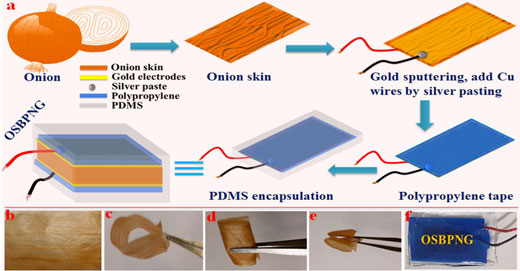Research Progress
Powering a piezoelectric nanogenerator with onion skin bio waste
Post: 2017-11-15 21:08 View:2830
| Nanogenerators are innovative self-powered energy harvesters that convert kinetic energy created from vibrational and mechanical sources into electrical power, removing the need of external circuits or batteries for electronic devices (read more: "Nanotechnology for self-powered systems"). | |
| Self-powered nanotechnology based on one type of nanogenerators – piezoelectric nanogenerators (PNGs) – aims at powering nanodevices and nanosystems using the energy harvested from the environment in which these systems are suppose to operate. This offers a completely new approach for harvesting mechanical energy using organic and inorganic materials. | |
| "The development of non-toxic, ultra-sensitive, and flexible bio-inspired piezoelectric nanogenerators has become a great challenge for next generation biomedical applications," Jin Kon Kim, a professor in the Department of Chemical Engineering at Pohang University of Science and Technology, and Director of National Creativity Research Initiative Program for Smart Block Copolymers, tells Nanowerk. "Many high-performance organic/inorganic materials based piezoelectric nanogenerators have some limitations due to their toxicity, non-biodegradable/ non-biocompatibility, brittleness as well as complex synthesis and fabrication steps. For biomedical health monitoring, body attachable and implantable self-powered PNGs device should be non-toxic and biocompatible." | |
| In new work published in Nano Energy ("Bio-waste onion skin as an innovative nature-driven piezoelectric material with high energy conversion efficiency"), Kim and his team, who worked jointly with Prof. Bhanu Bhusan Khatua, Indian Institute of Technology Khargapur, India, report a novel bio-piezoelectric nanogenerator (BPNG) using naturally abundant, self-aligned cellulose fibrous untreated onion skin as efficient piezoelectric material, having piezoelectric strength of ∼2.8 pC/N. | |
| The fabricated onion skin BPNG (OSBPNG) is capable of harvesting several types of mechanical energies, including body movements, wind flow and even machine vibrations and generated output voltage, current, instantaneous power density and high piezoelectric energy conversion efficiency of ∼18 V, ∼166 nA, ∼1.7 µW/cm2, and ∼61.7%, respectively, and turned on 30 green LEDs by a single device under repeated compressive stress of ∼34 kPa and ∼3.0 Hz frequency. | |
| In addition, the team achieved a maximum output voltage (∼106 V) when they connected 6 units in series, which instantaneously turned on 73 combined LEDs (30 green, 25 blue, and 18 red). | |
 |
|
| (a) Schematic of fabrication of OSBPNG with cross-section view. (b) Photograph of onion skin. The demonstration of flexibility of OS during (b) bending, (d) rolling, and (e) twisting, respectively. (f) Photograph of OSBPNG. (© Elsevier) (click on image to enlarge) | |
| To explore the potential application of OSBPNG in harvesting energy from human body motions, even at resting condition, the researchers carried out experiments by attaching OSBPNG to the human chest. | |
| " Our OSBPNG is highly effective during throat movement such as coughing, drinking and swallowing," notes Kim. "Furthermore, because it works at very low pressure originating from heart pulse or beat, it could be used in pacemakers and health care units. Finally, OSBPNG successfully differentiates speech signals, indicating its potential for speech recognition." | |
| Many commercial piezoelectric materials have suffered from limitations due to their toxicity, non-biodegradable/non-biocompatibility, brittleness as well as complex synthesis and fabrication requirements. In addition, the reported biocompatible piezoelectric materials show low power density and low energy conversion efficiency. | |
| "Till now, the origin of piezoelectricity in biomaterials is not completely understood due to their unusual behavior and they do not follow the classic models of piezoelectric theories based on idealized, crystalline structures," says Kim. "From the previous literature we know that the pure cellulose fiber exhibit shear piezoelectricity due to uniaxially oriented system of cellulose crystal but cellulose can also show longitudinal piezoelectric sensitivity under vertical compression." | |
| Onion skin consists of α-cellulose, carbonyl, carboxyl, and amino groups, as well as N-containing bio-ligands and quercetin as plant pigment (flavonoid). Being biodegradable, it could be very useful in various in vivo biomedical diagnostic applications compared to other piezoelectric materials. | |
| As onion skin is naturally abundant in huge amounts worldwide, it could be very helpful to generate electricity especially for rural development as well as many continents where still now no electricity, by this simple and cost-effective approach. The OSBPNG generate high power density and high energy conversion efficiency compared to other reported bio-piezoelectric materials. | |
| "This biocompatible inexpensive bio-wasted recyclable onion skin based highly durable self-powered OSBPNG could be a very promising biopiezoelectric material to fabricate self-powered nanogenerators as alternative green energy resource for powering small electronic devices and would be also applicable in large scale industrial applications," Kim concludes. | |
|
By Michael Berger – Michael is author of two books by the Royal Society of Chemistry: Nano-Society: Pushing the Boundaries of Technology and Nanotechnology: The Future is Tiny. Copyright © Nanowerk
Read More:https://www.nanowerk.com/spotlight/spotid=48645.php
|
Address: C508 Dingxin Building, Jilin University, 2699 Qianjin Street, Changchun 130012, P. R. China
Copyright © 2024 International Society of Bionic Engineering All Rights Reserved
吉ICP备11002416号-1
Copyright © 2024 International Society of Bionic Engineering All Rights Reserved
吉ICP备11002416号-1









